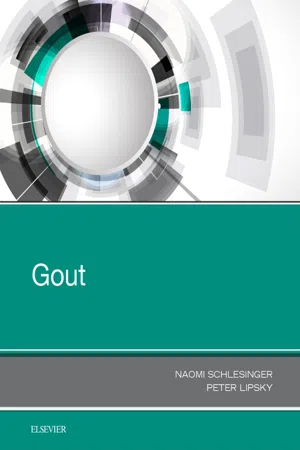
- 400 pages
- English
- ePUB (mobile friendly)
- Available on iOS & Android
About this book
Concise and clinically focused, Gout, by Drs. Naomi Schlesinger and Peter E. Lipsky, provides a one-stop overview of recent developments regarding this common form of inflammatory arthritis. Impacting an estimated 8.3 million people in the U.S. alone, gout is seen frequently by both primary care physicians as well as rheumatologists. This resource provides detailed coverage of the epidemiology, causes, diagnosis, management, and treatment of patients with both acute and chronic gout.- Addresses key topics such as genetics, hyperuricemia, comorbidities of gout, treatment guidelines for acute and chronic gout, classification and diagnosis, and imaging.- Discusses future outlooks for improving pharmacological and nonpharmacological treatment options, including an overview of drugs in the pipeline.- Consolidates today's available information on this timely topic into one convenient resource.
Frequently asked questions
- Essential is ideal for learners and professionals who enjoy exploring a wide range of subjects. Access the Essential Library with 800,000+ trusted titles and best-sellers across business, personal growth, and the humanities. Includes unlimited reading time and Standard Read Aloud voice.
- Complete: Perfect for advanced learners and researchers needing full, unrestricted access. Unlock 1.4M+ books across hundreds of subjects, including academic and specialized titles. The Complete Plan also includes advanced features like Premium Read Aloud and Research Assistant.
Please note we cannot support devices running on iOS 13 and Android 7 or earlier. Learn more about using the app.
Information
Hyperuricemia and the Silent Deposition of Monosodium Urate Crystals
Abstract
Keywords
Definition of Hyperuricemia
Consequences of Hyperuricemia
Table of contents
- Cover image
- Title page
- Table of Contents
- Copyright
- List of Contributors
- Preface
- Dedication
- Chapter 1. Hyperuricemia and the Silent Deposition of Monosodium Urate Crystals
- Chapter 2. Genetics of Hyperuricemia and Gout
- Chapter 3. Immunoinflammatory Nature of Gout
- Chapter 4. Tophi: Clinical and Biological Features
- Chapter 5. Crystal Analysis in Synovial Fluid
- Chapter 6. Epidemiology of Gout and Hyperuricemia
- Chapter 7. Comorbidities in Gout
- Chapter 8. Imaging of Gout
- Chapter 9. Gout Classification and Diagnosis
- Chapter 10. Clinical Features of Gout and Its Impact on Quality of Life
- Chapter 11. Quality of Life
- Chapter 12. Treatment Guidelines: The Good, the Bad, the Ugly
- Chapter 13. Nonpharmacologic Treatment of Gout
- Chapter 14. Pharmacologic Treatments: Acute Gout
- Chapter 15. Current Pharmacological Treatments of Chronic Gout
- Chapter 16. Treat to Target
- Chapter 17. Drugs in the Pipeline
- Epilogue
- Index